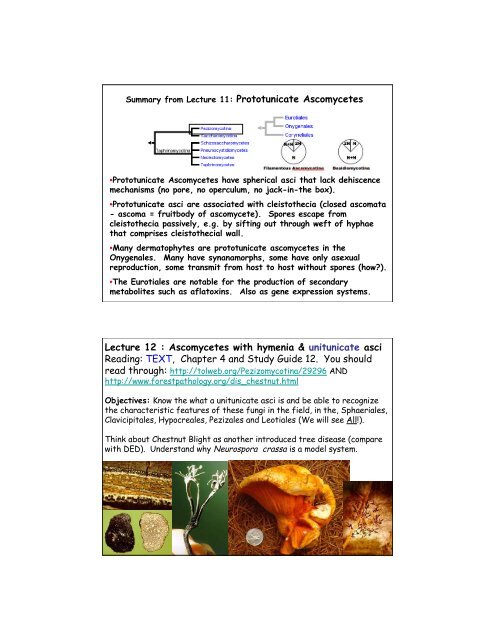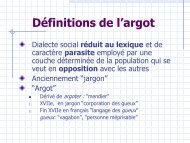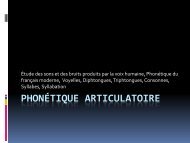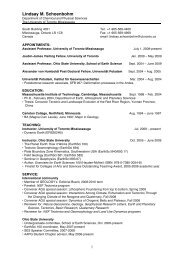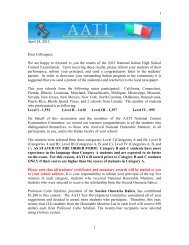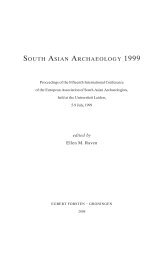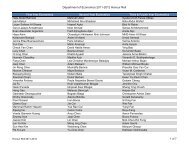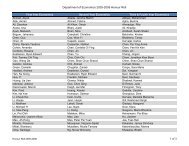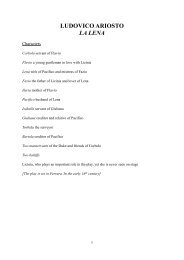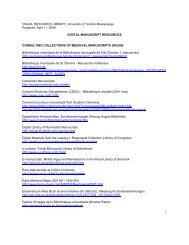Diatrype disciformis (Hoffm.) Fr.
Diatrype disciformis (Hoffm.) Fr.
Diatrype disciformis (Hoffm.) Fr.
Create successful ePaper yourself
Turn your PDF publications into a flip-book with our unique Google optimized e-Paper software.
Summary from Lecture 11: Prototunicate Ascomycetes<br />
•Prototunicate Ascomycetes have spherical asci that lack dehiscence<br />
mechanisms (no pore, no operculum, no jack-in-the box).<br />
•Prototunicate asci are associated with cleistothecia (closed ascomata<br />
- ascoma = fruitbody of ascomycete). Spores escape from<br />
cleistothecia passively, e.g. by sifting out through weft of hyphae<br />
that comprises cleistothecial wall.<br />
•Many dermatophytes are prototunicate ascomycetes in the<br />
Onygenales. Many have synanamorphs, some have only asexual<br />
reproduction, some transmit from host to host without spores (how?).<br />
•The Eurotiales are notable for the production of secondary<br />
metabolites such as aflatoxins. Also as gene expression systems.<br />
Lecture 12 : Ascomycetes with hymenia & unitunicate asci<br />
Reading: TEXT, Chapter 4 and Study Guide 12. You should<br />
read through: http://tolweb.org/Pezizomycotina/29296 AND<br />
http://www.forestpathology.org/dis_chestnut.html<br />
Objectives: Know the what a unitunicate asci is and be able to recognize<br />
the characteristic features of these fungi in the field, in the, Sphaeriales,<br />
Clavicipitales, Hypocreales, Pezizales and Leotiales (We will see All!).<br />
Think about Chestnut Blight as another introduced tree disease (compare<br />
with DED). Understand why Neurospora crassa is a model system.
Tree of Life http://tolweb.org/Pezizomycotina/29296 is up-to-date and DNA sequence-based.<br />
We are still in the Pezizomycotina, but in new classes today. Your Text, The Fifth<br />
Kingdom presents a taxonomy based on ascus and ascoma (unitunicate inoperculate asci<br />
in perithecia, called Pyrenomycetes; or unitunicate asci, in apothecia, called<br />
Discomycetes in many texts). Unitunicate, operculate asci are only in the order Pezizales.<br />
Green arrow = lichenized<br />
Series Unitunicatae-Operculatae<br />
Order Pezizales: 150 genera, 900 species. The 'operculate discomycetes'<br />
-- Your TEXT looks at 7 of the 13 families currently recognized.<br />
Familiy Pezizaceae is the core of the Order: Their asci have a diagnostic pop-open<br />
lid or operculum, and the tips of the asci are amyloid (sometimes expressed as I+ -this<br />
means giving a blue, starch-like reaction in an iodine solution known as<br />
Melzer's reagent). Below right: evolution of hypogeous forms (the true Truffles):
Photo from Algonquin Park, BIO 335 trip, 2010: Operculate ascus –no “toilet” lid yet<br />
- Note tip of ascus is blue in Melzer’s reagent. See that ascus tip is thin.<br />
- Note 8 ascospores with reticulate walls, each contain 2 oil vacuoles.<br />
Order Pezizales (Pezizales is placed in order Pezizomycetes in<br />
Tree of Life), Family Morchellaceae<br />
Morel<br />
Choice Edible<br />
Verpa (left 2 photos)<br />
May be Poisonous<br />
Gyromitra infula<br />
Poisonous.<br />
Morel (right 2 photos)<br />
Choice Edible<br />
TEXT
Order Pezizales<br />
Family Tuberaceae - the truffles.<br />
The inoperculate ascus has a<br />
thick tip that is perforated by a<br />
pore (there is a hole through the<br />
tip). The pore wall may turn<br />
blue in Melzer’s reagent.<br />
Ascus (showing an apical perforation<br />
pore with the wall turning blue in<br />
iodine solution), paraphyses and<br />
ascospores of Mollisia ventosa. ©<br />
Hans-Otto Baral<br />
http://tolweb.org/Leotiomycetes<br />
The ascomata are closed, hypogeous and<br />
solid (no air spaces any more -- as you can<br />
see in this bisected specimen of Tuber<br />
aestivum, which a truffle dog brought to me<br />
at Scheggino in Italy)<br />
The asci, produced in a highly convoluted<br />
hymenium, are rounded and thin-walled<br />
(those of Tuber albidum are shown at left)<br />
with no trace of an operculum or other<br />
shooting mechanism, and usually contain<br />
only 1-3 spores. TEXT.
Order Leotiales: 13 families, 400 genera, 2000 species. The 'inoperculate<br />
discomycetes.' The apothecial ascomata are superficially similar to those of the<br />
Pezizales, but the asci are inoperculate, and usually have amyloid apical ring.<br />
Family Sclerotiniaceae (images from Prof. Kohn and TEXT).<br />
As the name implies, these fungi often form sclerotia, which may be solid<br />
masses of fungal tissue, or may be of mixed origin -- fungal hyphae riddling a<br />
mummified host such as a peach, plum or cherry, or a catkin (right). Having<br />
overwintered in this guise, they germinate in spring and use the stored energy<br />
to produce stalked apothecial ascomata (right). Ascospores are shot when the<br />
host is in flower, and gain entrance through the stigma.
Order Leotiales: Sclerotiniaceae.<br />
http://www.agf.gov.bc.ca/cropprot/tfipm/brownrot.htmt<br />
http://www.apsnet.org/education/LessonsPlantPath/BrownRo<br />
t/text/CYCLE.HTM Also TEXT<br />
Order Leotiales: Family Leotiaceae contains some more normal-looking<br />
'discomycetes' such as Bisporella, which produces those small yellow<br />
discoid apothecia so common on fallen, decorticated tree-trunks...<br />
Family Geoglossaceae - literally "earth-tongues"<br />
TEXT
http://www.naturefg.com/pages/fu-ascomycota.htm Nature Photography by Dragiša Savić<br />
Holwaya mucida is a Leotiales fungus with black, gelatinous, turbinate apothecia (sexual<br />
fruitbodies also called ascomata, singular is ascoma). The asexual stage is large also –<br />
note the white head is mucilaginous and contains numerous asexual conidia (mitospores).<br />
Amit Patel collected the anamorph (mitosporic, asexual state) at Algonquin Park.<br />
Tree of Life http://tolweb.org/Pezizomycotina/29296 is up-to-date and DNA sequence-based.<br />
We are still in the Pezizomycotina, but in new classes today. Your Text, The Fifth<br />
Kingdom presents a taxonomy based on ascus and ascoma (unitunicate inoperculate asci<br />
in perithecia, called Pyrenomycetes; or unitunicate asci, in apothecia, called<br />
Discomycetes in many texts). Unitunicate, operculate asci are only in the order Pezizales.<br />
Green arrow = lichenized
Order Sphaeriales: 225 genera, 1300 species.<br />
Dark, crusty, globose to pear-shaped individual perithecial<br />
ascomata with prominent ostioles.<br />
OR many perithecial cavities immersed in a single stroma to<br />
form a compound fructification, as in Xylaria below<br />
The asci often have an apical ring or sphincter, which is<br />
usually, though not always, amyloid (stains blue in iodine).<br />
Thread-like, sterile elements called paraphyses are present<br />
between the asci in the hymenium of some members, absent<br />
from others<br />
Ascospores can be light or dark, simple or septate, with or<br />
without germ pore or slit, sometimes with gelatinous sheaths or<br />
appendages.<br />
<strong>Diatrype</strong> <strong>disciformis</strong> (<strong>Hoffm</strong>.) <strong>Fr</strong>.<br />
http://www.bioimages.org.uk/html/P158449.HTM
Nature 422, 859 - 868 (24 April 2003); doi:10.1038/nature01554<br />
The genome sequence of the filamentous fungus<br />
Neurospora crassa<br />
Neurospora crassa is a central organism in the history of twentiethcentury<br />
genetics, biochemistry and molecular biology. Here, we<br />
report a high-quality draft sequence of the N. crassa genome. The<br />
approximately 40-megabase genome encodes about 10,000 proteincoding<br />
genes—more than twice as many as in the fission yeast<br />
Schizosaccharomyces pombe and only about 25% fewer than in the<br />
fruitfly Drosophila melanogaster. Analysis of the gene set yields<br />
insights into unexpected aspects of Neurospora biology including<br />
the identification of genes potentially associated with red light<br />
photobiology, genes implicated in secondary metabolism, and<br />
important differences in Ca2+ signalling as compared with plants<br />
and animals. Neurospora possesses the widest array of genome<br />
defence mechanisms known for any eukaryotic organism, including<br />
a process unique to fungi called repeat-induced point mutation<br />
(RIP). Genome analysis suggests that RIP has had a profound<br />
impact on genome evolution, greatly slowing the creation of new<br />
genes through genomic duplication and resulting in a genome with<br />
an unusually low proportion of closely related genes.<br />
Order Hypocreales: 80 genera, 550 species.<br />
This order is recognized by its brightly coloured, simple or compound,<br />
perithecial ascomata -- usually yellow, orange or red -- which are fleshy or<br />
waxy in texture, and usually borne on supporting layers of mycelium (subicula)<br />
or in stromata. Four genera are especially well-known.<br />
Nectria (27 spp) has bright red, superficial perithecia<br />
(right) containing 2-celled (didymosporous) ascospores.<br />
Some species cause cankers and die-backs of trees.<br />
Below: commonly encountered anamorph,<br />
Tubercularia, causes “coral spot”.Nectria species<br />
can cause cankers and die-backs of trees.
Order Hypocreales continued:<br />
The most economically important of the<br />
nectriaceous anamorphs are certain Fusarium<br />
specie), many of which cause destructive wilt<br />
diseases of higher plants, or produce mycotoxins.<br />
Gibberella also has Fusarium anamorphs, which<br />
are producing the reddish pigment seen in the<br />
picture<br />
The lower picture shows Gibberella (dark) and its<br />
Fusarium anamorph (reddish-orange) growing<br />
together on a corn cob.<br />
One species of Gibberella causes a disease of rice<br />
called 'foolish seedling' in which seedlings grow<br />
too rapidly and consequently fall over. The active<br />
principle, a plant growth hormone called<br />
gibberellic acid, has been extracted and is now<br />
widely used to stimulate plant growth.<br />
Order Hypocreales continued:<br />
TEXT<br />
Hypomyces lactifluorum, an orange fungus which,<br />
like other species of the genus, parasitizes<br />
basidiiomycetes, in this case the agaric genera<br />
Lactarius and Russula...<br />
Left: The ostiole is the opening of the perithecium.
Order Hypocreales continued:<br />
Hypocrea forms fleshy stromata on wood<br />
(LEFT). The dark spots are the ostioles of the<br />
embedded perithecial cavities.<br />
The teleomorph of Hypocrea is recorded far less<br />
often than its green-spored, phialidic<br />
anamorph, Trichoderma (lower right) which,<br />
because it is a broad-spectrum mycoparasite,<br />
and produces cellulases and antibiotics, is one of<br />
the most important moulds in forest soils. Used<br />
in biological control of pathogenic fungi and<br />
for production of enzymes which can convert<br />
cellulose to glucose.<br />
Order Clavicipitales: 27 genera,<br />
270 species.<br />
Sophisticated, obligate parasites:<br />
(a) frequently stalked, all-fungal<br />
stromata (below, A,B,D,E), (b)<br />
long asci without apical rings, but<br />
with thickened tips (below, right,<br />
F), and (c) long, thread-like<br />
ascospores that in some taxa<br />
fragment at or following release<br />
(below, right, F). TEXT.<br />
Trichoderma viride<br />
(anamorphic fungus)<br />
TEXT and:fungus)<br />
http://www.bioimages.org.uk/HTML/<br />
P164979.HTM
Chestnut Blight Disease<br />
Contributed by<br />
Sandra L. Anagnostakis<br />
Connecticut Agricultural Experiment Station<br />
Box 1106<br />
New Haven, CT 06504<br />
Phone 203-974-8498<br />
Sandra.Anagnostakis@po.state.ct.us<br />
Figure 1. An American chestnut stem with a chestnut blight canker. (Click image for larger view and more information).<br />
Chestnut blight, or chestnut bark disease, is caused by an introduced fungus, Cryphonectria parasitica<br />
(Murrill) Barr, (formerly Endothia parasitica [Murrill] Anderson & Anderson). The fungus enters wounds,<br />
grows in and under the bark (Fig. 1), and eventually kills the cambium all the way around the twig,<br />
branch, or trunk (33). Sprouts develop from a burl-like tissue at the base of the tree called the ‘root<br />
collar,’ which contains dormant embryos (39). Sprouts grow, become wounded and infected, and die, and<br />
the process starts all over again.<br />
Cankers were first reported in the United States in 1904 on American chestnut trees (Castanea dentata<br />
[Marshall] Borkhausen) (Fig. 2) in New York City (32). None of the control attempts (chemical treatments,<br />
clearing and burning chestnut trees around infection sites) were successful (47). By 1926 the fungus was<br />
reported throughout the native range of American chestnut (Fig. 3), and a major forest tree had been<br />
reduced to a multiple-stemmed shrub (17). In 1912 the Plant Quarantine Act was passed to reduce the<br />
chances of such a catastrophe happening again (49).<br />
Fig. 1<br />
Fig 3<br />
Fig. 1. An American chestnut stem with a chestnut blight canker (Castanea dentata with a<br />
Cryphonectria parasitica canker). The fungus enters through wounds such as the broken branch<br />
stub on the left, and grows in and under the bark, killing the cambium. Fungal stromata break<br />
through the lenticels and pycnidia producing conidia and perithecia producing ascospores are<br />
formed. Photo by R. A. Jaynes.<br />
Fig. 2. An American chestnut tree (Castanea dentata [Marshall] Borkhausen) growing in Scotland,<br />
Connecticut in 1905. The tree was 83 feet tall, 27 inches in diameter, and 103 years old.<br />
Figure 3. The natural range of American chestnut as presented by Saucier in 1973<br />
http://www.apsnet.org/online/feature/chestnut/top.html<br />
Fig. 2
Tree of Life http://tolweb.org/Pezizomycotina/29296 is up-to-date and DNA sequence-based.<br />
We are still in the Pezizomycotina, but in new classes today. Your Text, The Fifth<br />
Kingdom presents a taxonomy based on ascus and ascoma (unitunicate inoperculate asci<br />
in perithecia, called Pyrenomycetes; or unitunicate asci, in apothecia, called<br />
Discomycetes in many texts). Unitunicate, operculate asci are only in the order Pezizales.<br />
Green arrow = lichenized<br />
Ascoma<br />
(teleomorph)<br />
Ophiostoma ulmi causes<br />
Dutch Elm Disease.<br />
Hair-like hyphae at the top<br />
Of ascoma.<br />
Graphium anamorph Synnemata.<br />
Sporothrix anamorph<br />
Order Ophiostomatales (Sordariomycetes in Tree of Life): 15 genera, 130 species.<br />
Ascomata have long, tubular necks, with the ostiole at the tip. The asci are not<br />
arranged in a hymenium, and autolyse early. The spores ooze out of the ostiole and<br />
form a slimy droplet that is supported by a ring of specialized, hair-like hyphae at<br />
the top of the neck.These fungi often fruit in bark beetle tunnels - elevated spore<br />
drop ensurse beetle carries spores with it when it flies off in search of another tree.<br />
Ophiostoma ulmi, my example of the Ophiostomatales, has a Graphium anamorph<br />
that produces many conidiomata each bearing a slimy droplet of conidia at its tip -<br />
anamorph is completely analogous to the teleomorph; both ensure that beetles<br />
don't leave home without them. Another anamorph, Sporothrix, produces conidia<br />
and yeast cells in tree xylem, releasing wilt toxin, cerato-ulmin. FROM TEXT.
Plant Disease Lessons: http://www.apsnet.org/Education/LessonsPlantPath/DutchElm/top.htm<br />
As early as June, the leaves on a DED-infected elm<br />
will wilt, turn yellow, then curl and turn brown.<br />
Symptoms usually first appear in the crown on the<br />
tree, and can be seen until fall colours appear.<br />
Dutch elm disease is spread by the native elm bark<br />
beetle which can fly up to 2 km as it searches for<br />
healthy elms to feed on. The DED fungus has sticky<br />
spores that become attached to the beetle during<br />
its breeding period. The beetle then spreads the<br />
fungus when it feeds on and over-winters in healthy<br />
elms.<br />
Do not prune your elms between April 13th and July<br />
31st. The Elm Bark Beetle that spreads the DED<br />
fungus is attracted to freshly cut elm and is most<br />
active during this period.<br />
http://www.sdeda.ca/what_is.html<br />
http://www.fs.fed.us/na/morgantown/fhp/palerts/ded/elm.htm
DED early symptoms:<br />
Yellowing of leaves in<br />
crown.<br />
http://www.sdeda.ca/what_is.html<br />
DED symptoms: brown discoloration of xylem.


